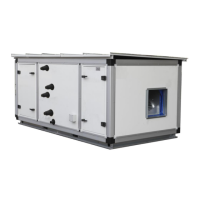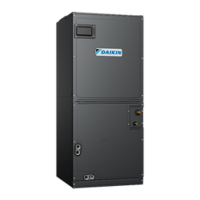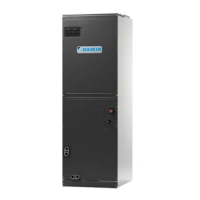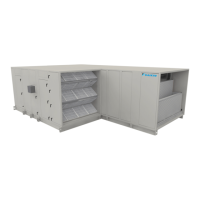Do you have a question about the Daikin Altherma 3 RMT ECH2O and is the answer not in the manual?
Explains how to locate items in the user interface menu structure.
Covers essential safety guidelines and warnings for appliance operation and maintenance.
Provides critical safety warnings regarding refrigerant flammability and unit storage.
Illustrates the main components of a Daikin Altherma system with labels.
Explains different user access levels and their permissions for system settings.
Instructions on operating heating/cooling and adjusting room/water temperatures.
Guides on turning tank heating ON/OFF and setting the tank temperature.
Describes the components and functions of the user interface, including LEDs and buttons.
Provides a detailed map of the user interface menu options and their hierarchy.
Explains the elements displayed on the home screen, showing unit status and key information.
Illustrates common screens like Home, Main menu, and Setpoint screens with their elements.
Details how to navigate the main menu to access various submenus and settings.
Describes setpoint screens for system components like room temperature and tank temperature.
Explains how to view detailed values and settings on specific screens.
Guides on enabling/disabling space heating/cooling and tank heating operations.
Shows how to access system information such as energy data and malfunction history.
Details how to set and restrict space operation modes like heating, cooling, and automatic.
Explains how to adjust the desired room temperature via the setpoint screen.
Guides on adjusting the desired leaving water temperature for heating emitters.
Covers reheat mode and scheduled reheat mode for domestic hot water.
Provides an example of how to set a room temperature schedule for the main zone.
Explains how to use the powerful operation for faster domestic hot water heating.
Step-by-step guide to programming a daily schedule for room temperature control.
Instructions for copying schedules and naming/renaming custom schedules.
Provides tables and instructions for configuring weather-dependent curves.
Explains the concept of weather-dependent operation and its energy-saving benefits.
Introduces the two types of weather-dependent curves: 2-points and slope-offset.
Lists which zones and functions support weather-dependent curve adjustments.
Details how to define a 2-points weather-dependent curve using setpoints.
Explains how to define a slope-offset weather-dependent curve using slope and offset.
Offers advice on setting room temperatures to optimize energy savings and comfort.
Provides guidance on setting domestic hot water temperatures for efficiency.
Outlines end-user responsibilities and installer maintenance tasks.
Guides on accessing detailed error descriptions and codes for malfunctions.
Explains how to view a list of past malfunctions for diagnosis.
Addresses issues with room temperature not reaching the desired setpoint.
Helps diagnose and resolve issues with insufficient domestic hot water temperature.
Describes how the system behaves during heat pump failure and backup heater activation.
Provides troubleshooting steps for gurgling noises, often related to air or hydraulic balance.
Warns against self-dismantling and emphasizes proper disposal procedures for the unit.
Provides tables for recording system configuration settings during installation.
Lists settings accessible via the menu, referencing specific sections for details.
This document serves as the operation manual for the Daikin Altherma 3 R MT ECH₂O system, providing users with essential information for its safe and efficient use. It is part of a comprehensive documentation set that includes general safety precautions, a user reference guide, installation manuals for both outdoor and indoor units, an installer reference guide, and an addendum book for optional equipment. The manual emphasizes the importance of reading all documentation carefully before operating the user interface to ensure optimal performance and encourages users to consult their installer for system configuration details.
The Daikin Altherma 3 R MT ECH₂O system is designed to provide space heating and cooling (for reversible models), as well as domestic hot water production. Depending on the system layout, it can heat or cool a main zone (e.g., living room) and additional zones (e.g., bedroom), and produce domestic hot water stored in an energy storage tank. The system utilizes a heat pump, with an outdoor unit and an indoor unit, and can connect to various heat emitters such as underfloor heating, radiators, heat pump convectors, or fan coil units. A dedicated Human Comfort Interface (BRC1HHDA) or an external room thermostat can be used to control room temperature.
The system features a user interface with an LCD screen, dials, and buttons for navigation and setting adjustments. A status indicator with LEDs shows the unit's operating mode (standby, operation, or malfunction). The ON/OFF operation for space heating/cooling and tank heating can be controlled via the user interface. The system also supports weather-dependent operation, where the desired leaving water or tank temperature is automatically adjusted based on the outdoor ambient temperature, aiming to optimize energy consumption.
For domestic hot water, the system offers a "Reheat mode" where the storage tank continuously heats to a set temperature when it drops below a certain value. A "Scheduled reheat mode" allows the tank temperature to vary according to a programmed schedule. Additionally, a "Powerful operation" mode can be activated to quickly heat domestic hot water using a backup or booster heater, useful during periods of high demand.
The user interface allows for various adjustments and monitoring:
The manual outlines maintenance responsibilities for both the installer and the end-user:
| Refrigerant | R-32 |
|---|---|
| Hot Water Tank Material | Stainless Steel |
| Type | Air-to-Water Heat Pump |
| Heating Capacity | 4.0 - 16.0 kW |
| Energy Efficiency Class (Heating) | A+++ |
| Energy Efficiency Class (Cooling) | A++ |
| Operating Temperature Range (Heating) | -25 to 35 °C |
| Operating Temperature Range (Cooling) | 10 to 46 °C |











